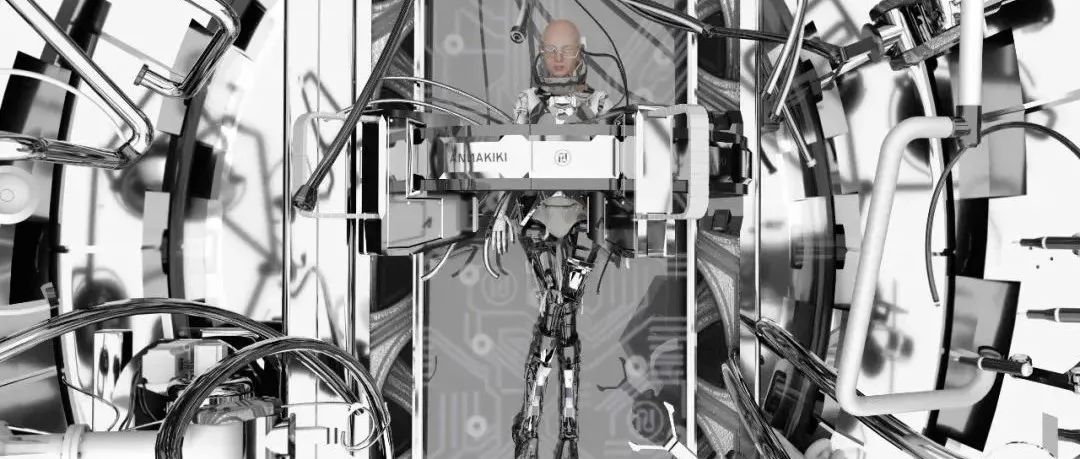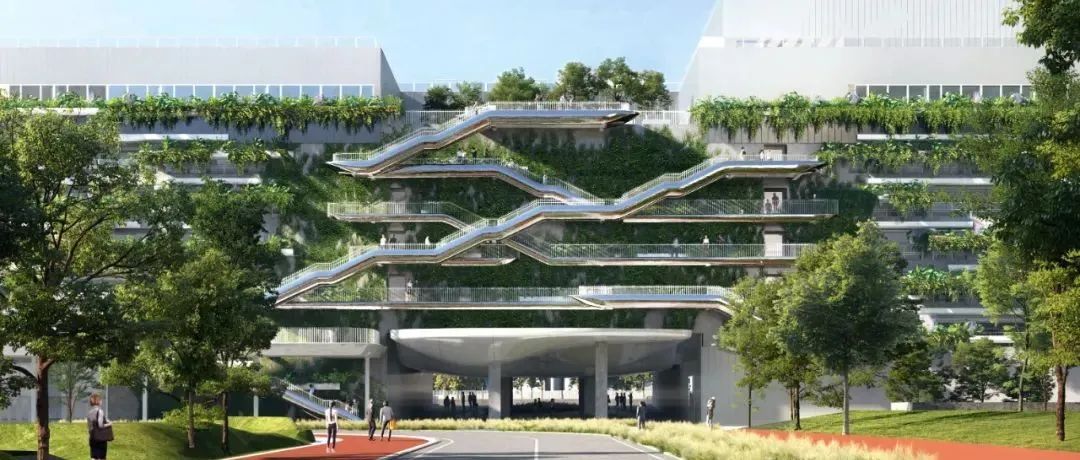HOK的设计和技术领导者们分享了他们对于元宇宙的见解。
元宇宙(Metaverse)是否是一个被过度炒作的20世纪90年代科幻小说的流行语,还是一个会影响我们生活方方面面的数万亿的商机?元宇宙到底是什么?
关于元宇宙对建筑师和设计师会有什么影响的各种观点,几乎和元宇宙本身的定义一样多。元宇宙通常用来描述互联网的未来迭代——人们沉浸在一个3D虚拟现实世界中,在那里人们可以互动还能进行现实世界的活动。
无论定义为何,元宇宙正在到来。无处不在的智能手机和手表、AR/VR头盔、沉浸式电子游戏、Peloton屏幕和未来派的特斯拉仪表盘,从某种意义上讲,它已经渗入到生活的很多场景中。随着摩尔定律开始发生作用,技术不断加速这种物理和数字环境的融合,设计行业将需要领先一步。
3D沉浸式的元宇宙将为设计公司带来改变,包括他们的工作方式、提供的服务以及最终的设计成果。由此而生的机遇,包括从创造一个模仿了物理世界的平行数字化宇宙到开发全新的元宇宙和随之产生的收益流。
建筑环境的设计者们已经准备好立即与元宇宙互动。“我们设计的所有物理空间,包括室内、建筑、园区和城市空间,都是作为元空间而诞生的,”HOK旧金山办公室的规划总监Brian Jencek说。“我们只是把它们称为3D模型。我们早已使用游戏设计师的许多工具来建造具有真实感的虚拟环境,这些工具包括Blender、虚幻引擎(Unreal Engine)、Unity 和Twinmotion。”
数字沙盒和互联传感器
HOK长期以来一直使用虚拟现实(VR)和增强现实(AR)工具,使客户能够沉浸在拟建的空间中,无论是体育馆、医院还是实验室。这些工具能模拟建筑性能,演绎各种方案。例如,它们可以对纽约市进行建模,以展示如果人口规模增长1000万,海平面上升1.8米,将会是什么样子。
新兴技术将使我们在拟建或现有建筑内与客户进行沟通,并实时修改设计。或者由设计公司创建一个虚拟空间,分散在世界各地的设计师们能以逼真的化身,聚集在一起进行合作。它还会带来一种可能,即创建一个真正的数字孪生(digital twin )——一个准确反映真实建筑并以实时数据更新的虚拟模型。HOK多伦多的设计技术专家Chloe Sun说:“数字孪生将从连接的物联网(Internet of Things)传感器接收数据,从设计到运营综合角度来讲述一个建筑在整个生命周期内的性能表现。”
然而,就目前而言,虚拟建筑主要还是存在于只读环境,只有在其所有者提供最新信息时才会更新。“目前还没有技术能够完全精确地复制3D空间,主要还停留在用数据链接来捕捉静态元素阶段,”HOK纽约的设计技术总监Greg Schleusner说,“我们甚至没有办法对一个人走过一扇门这样简单的事情进行建模。”
到什么时候,元宇宙才能足够逼真以模拟现实?“人们是非常善于辨假的,”Brian Jencek说。“我可以给你看一张我用Photoshop修改过的效果图,你在几秒内就会发现修改过的地方。尽管技术空前地发达,但元宇宙要模拟现实,还有很多工作要做。”
设计一个更好的元宇宙
作为一个立足于现实的人,我很难抉择。但我们在元宇宙中的角色之一也可以是设计这些梦幻般的环境。
Brian Jencek
HOK规划总监
另一种关于元宇宙的愿景是专注于创造与现实完全不同的沉浸式环境,而不是聚焦于数字工具、传感器和数据。“我们逃避重力只为了在虚拟建筑中重新创造重力,这听上去是有些奇怪,”Brian Jencek说,“如果我们设计一个虚拟体育场,你漂浮在球场上方,周围各个方向都有人:上、下、左、右,到处都是人,那会是怎样的体验?你想飞到国际空间站吗?或者在瑞士阿尔卑斯山的一块虚拟土地上拥有一座虚拟酒庄的NFT(Non-Fungible Token;非同质化代币)吗?我们甚至可以把山羊放进去! 作为一个立足于现实的人,我很难抉择。但我们在元宇宙中的角色之一也可以是设计这些梦幻般的环境。”
一座建筑的数字孪生也将提升人们在现实生活中对该建筑的体验。“想象一下,一个场馆能举办容纳数千人的现场音乐会,”Chloe Sun说,“通过使用数字孪生,能够容纳更多的观众——可能是数以百万计的观众——以虚拟的方式参加并能互动交流。”
Epic Games已经在其《堡垒之夜》电子游戏中举办了一系列的互动式演唱会,包括Travis Scott和Ariana Grande。“我们可以为音乐会场馆设计20种不同的皮肤,让用户选择自己喜欢的主题式体验,”HOK堪萨斯城办公室的资深项目设计师Rashed Singaby说,“或者我们可以设计我们自己的数字艺术资产,作为NFT来销售。更不用说,我们的项目在元宇宙中可以提供不同的体验,观众可以线上参观我们设计过的建筑。从为元宇宙进行设计到利用它的影响力,之中的潜力几乎是无限的。”
对于善于克服限制条件的建筑师们来说,所面临的挑战将是在虚拟世界中完全释放他们的想象力,用接近幻想的水平进行思考。“电子游戏中的建筑没有规则,” Rashed Singaby说,“建筑师可以利用电子游戏设计师一直在做的事情来创造迷人的、奇幻的体验。我们中的更多人可能需要学习编码。”
“每个设计师的电脑硬盘里都存放着一些令人惊艳的设计,”熟知编码的Chloe Sun补充道,“它们可以在元宇宙中复苏,在那里我们有更多的机会与世界分享我们的创造力。”
当建筑设计师持续观察这个不断增长的虚拟世界的模式和需求时,他们也开始逐渐建立起相关的设计标准。当HOK开始建立其电竞场馆设计的知识库时,设计师们研究了《英雄联盟》等几个热门的电子游戏,以了解电竞比赛是如何运作的。“然后,我们研究了传统的体育竞技市场,从场馆布局和其配套设施,到这些运动是怎样被媒体转播的,从而更好地了解电竞节目的录制与播放方式,”Rashed Singaby说。“在此基础上,我们建立了电子竞技场馆的设计标准。随着传统体育联赛注意到电竞比赛中物理世界和数字世界的融合,他们也学习并掌握了其中的一些精髓。”
这种朝着沉浸式虚拟体验方向的演变,是否也会在其他建筑类型的设计中发生?“变化已经开始在办公、医疗、教育、娱乐和商业项目中体现,”Rashed Singaby说。“每个专业领域的设计师都应该考虑元宇宙将如何在未来的十年内极大地改变他们客户的需求。”
元宇宙中的ESG*
我担心脱离自然对人类的整体影响。我们是生物体,而不是数字对象(digital objects)。
David Weatherhead
HOK设计总监
*ESG: Environmental, social and corporate governance;环境、社会和治理
在元宇宙中,将有大量的环境、社会和治理问题需要解决。
在环境方面,为虚拟世界提供动力所需的更多数据处理和网络流量,可能会大大增加电力的消耗。同时,我们在数字世界中进行的更多活动将减少运输中的碳排放,同时遏制资源的使用和浪费。“我担心脱离自然对人类的整体影响,”HOK伦敦办公室设计总监David Weatherhead说,“我们是生物体,而不是数字对象。”
对设计师来说元宇宙会更加没有障碍。“无论性别、种族、国籍或性取向如何,我们在元宇宙市场中都有相对平等的机会,”Chloe Sun说。“我们也能设计出具有文化包容性、无障碍的环境。”
保有实体建筑的数字孪生可以推进公平合理性。HOK多伦多的设计技术总监Mark Cichy说: “建筑的这种实体和数字的融合,将为人们提供许多对其众多资源的线下和线上的访问方式。”
随着越来越多的真人参与到元宇宙的虚拟世界中,设计者将不得不考虑治理、安保、安全和隐私相关的问题。在现实世界中可能犯下的罪行,比如骚扰或偷窃,也很大概率会在元宇宙中发生类似情况。“在尊重个人的虚拟社区中,人们需要遵守哪些规则和法律?”Rashed Singaby问道,“这不是我们要解决的问题,但作为倡导人性化的建筑师,该空间的管理和安全是我们责任的一部分。”
平衡之道
单维的、纯数字建筑的设计者不受限于建筑安全规范、材料、可施工性甚至是重力。建筑师们习惯于遵循的规则在元宇宙中消失了,那里的建筑甚至不需要看上去像建筑。“然而,作为现实世界中的建筑师,我们花很多时间来优化设计,从而能够提供满足规范的,且卓越的解决方案。”David Weatherhead说。“当我参与设计世界最高建筑时,团队的目标是在确保技术上可行和造价合理的情况下使其尽可能地高。如果没有这些实际的限制,我们的技能和创新能力可能会在某种程度上被轻视,而工程学则会消失。”
我们想要持续推进元宇宙,直到它是能映射并帮助现实世界的版本。
Greg Schleusner
HOK设计技术总监
Mark Cichy也认为,在元宇宙中,建筑师的角色有被商品化的风险。“从建筑物的设计开始,我们就与客户在一起参与项目,一直到入住和后续的运营,”他说,“建筑师所做的事情可比单纯地设计漂亮的建筑要强大和丰富许多。”
将元宇宙仅仅作为对现实的一种逃避,或者把它想成不必进行现实互动的虚构世界的想法,在一些设计师看来也是反乌托邦的,因为他们持有希望能够建立一个更好的现实世界的乐观想法。“我们不会因为在生活中遇到困难或难关而逃避现实,”Greg Schleusner说,“那是电影场景中非常流行的‘头号玩家’版本。我们想要持续推进元宇宙,直到它是能映射并帮助现实世界的版本。”
想象一下,AR为我们在物理世界中看到的事物提供了一层3D模型的叠加。也许我们可以走过一个公园,查看一棵树的健康状况。或者实时查看一个历史建筑的信息。Mark Cichy说道:“数字世界和现实环境之间信息的双向流动可以提供巨大的价值。”
对我们来说,帮助界定这个新的数字世界将比忽视它要好。它正在发生。而我们要决定的是我们要如何参与其中。
Rashed Singaby
HOK资深项目设计师
David Weatherhead尽管承认对建筑师可以在元宇宙中创造无限维度的用户体验而感到好奇,但迄今还没有被一个纯数字的设计打动过。“然而,在感受一件伟大的建筑作品时,我可以很轻易地被感动,”他说道。“能够为数字建筑注入那种感染力和意义之前,我们还有很长的路要走。目前来说,我们可以使用这些工具来继续使现实世界成为一个更好的地方。”
关于建筑师和设计师在连接物理世界和虚拟世界中的作用的讨论才刚刚开始,并会不断发展。因为对这个新事物的不了解,一些人会对它产生畏惧,但Rashed Singaby认为设计师必须欣然接受这个机会。“对我们来说,帮助界定这个新的数字世界将比忽视它要好,” 他说道。“它正在发生。而我们要决定的是我们要如何参与其中。”
How Architects and Designers Can Help Define the Metaverse
HOK design and technology leaders share their thoughts on navigating the metaverse.
Is it an overhyped buzzword co-opted from a 1990s sci-fi novel or a multi-trillion-dollar opportunity that will affect nearly every part of our lives? And what exactly is it?
There are nearly as many working definitions of the metaverse as there are opinions about what it will mean to architects and designers. But it’s often used to describe a future iteration of the internet that immerses people in a 3D virtual reality world where people can interact and conduct real-world activities.
Whatever the definition, the metaverse is coming. Consider ubiquitous smartphones and watches, AR/VR headsets, immersive videogames, Peloton screens and futuristic Tesla dashboards. In many ways it’s already here. As Moore’s Law kicks in and technology continues to accelerate this convergence of physical and digital environments, the design profession will need to stay one step ahead.
The 3D, immersive metaverse will facilitate changes in how design firms work, the services they provide and the products they deliver. The opportunities range from creating a parallel digital universe that mimics the physical world to developing entirely new universes—and revenue streams.
Designers of the built environment are poised for immediate engagement with the metaverse. “All the physical spaces we design—interiors, buildings, campuses and cities—are born as meta spaces,” says Brian Jencek, HOK’s San Francisco-based director of planning. “We just call them 3D models. We’re already using many of the tools that game designers use—including Blender, Unreal Engine, Unity and Twinmotion—to create realistic-looking virtual environments.”
Of Digital Sandboxes and
Connected Sensors
HOK has long used virtual reality (VR) and augmented reality (AR) tools to immerse clients in a proposed space, be it a stadium, hospital office or lab. These tools can simulate building performance and play out various scenarios. They can model New York City, for example, to show what it will look like if the population grows by 10 million and the sea level rises by 6 feet.
Emerging technology will make it possible to meet with a client inside a proposed or existing building and alter the design in real time. Or for firms to host virtual spaces where, via realistic avatars, designers scattered all over the world can come together to collaborate. It also will be possible to create a true digital twin—a virtual model that accurately reflects a real building and is updated with real-time data. “A digital twin will receive data from connected Internet of Things sensors to tell the story of a building’s performance throughout its life cycle, from design through operations,” says Chloe Sun, design technology specialist in HOK’s Toronto office.
For now, however, virtual buildings predominantly remain read-only environments that only change as their owners publish updates. “The technology doesn’t exist yet to replicate 3D space in a fidelity that captures anything more than static elements with data links,” says Greg Schleusner, HOK’s New York-based director of design technology. “We don’t even have ways to model something as simple as a person walking through a door.”
At what point will the metaverse be realistic enough to simulate reality? “People are really good at spotting fakes,” says Jencek. “I could show you a rendering where I have used Photoshop to change one digital asset and you would see it in seconds. Though the technology has never been better, we have a lot of work to do if the metaverse is intended to twin reality.”
Designing a Better Metaverse
As someone anchored in reality, I’m torn. But one of our roles in the metaverse can be to design these fantastical environments.
Brian Jencek
Director of Planning, HOK
Another vision for the metaverse looks past digital tools, sensors and data to focus on the creation of immersive environments that bear no semblance to reality. “It’s strange to escape gravity only to re-create it in virtual buildings,” says Jencek. “What if we designed a digital-only stadium where you were floating above the field and there were people around you in every direction: up, down, left, right and everywhere? Do you want to fly to the International Space Station? Or own an NFT of a virtual chateau on a virtual piece of land in the Swiss Alps? We’ll even include the goats! As someone anchored in reality, I’m torn. But one of our roles in the metaverse can be to design these fantastical environments.”
A digital building twin also could be used to enhance people’s experiences in its real-life counterpart. “Imagine an arena that holds thousands of people for a live concert,” says Sun. “By using a digital twin, the performer will be able to accommodate a much larger audience—potentially millions—to attend virtually and interact with each other.”
Epic Games has already hosted a series of interactive musical performances, including Travis Scott and Ariana Grande, in its “Fortnite” video game. “We could design 20 different skins for that concert venue where the users choose their preferred thematic experience,” says Rashed Singaby, senior project designer for HOK in Kansas City. “Or we could design our own digital art assets that have value for sale as NFTs. Not to mention how our portfolio of projects can be experienced differently in the metaverse, with viewers able to virtually tour the buildings we designed. Between designing for the metaverse and leveraging its capabilities, the potential is almost limitless.”
The challenge for architects accustomed to overcoming constraints will be to free their imaginations to think on the level of fantasy possible in the virtual world. “There are no rules for buildings in video games,” says Singaby. “Architects can tap into what video game designers have been doing to create captivating, fantasy experiences. More of us may need to learn to code.”
“Every designer has amazing designs sleeping in their hard drives,” adds Sun, who already knows how to code. “We can revitalize them in the metaverse, where we have more opportunities to share our creativity with the world.”
As building designers monitor the patterns and needs of this growing virtual world, they can begin cultivating design standards. When HOK started to build its knowledge about designing for Esports, designers studied several popular video games, like “League of Legends,” to understand how their competitive events worked. “We then examined the traditional sports market—from venue layout and amenities to how these sports were being produced for broadcast—for cues,” says Singaby. “From this we developed design standards for venues to accommodate Esports. And as traditional sports leagues noticed the blend of physical and digital in Esports events, they were able to learn from and capture some of that magic.”
Will the same type of evolution toward immersive computing experiences also transform the design of other building types? “It’s already starting to happen across workplace, healthcare, education, entertainment and retail projects,” says Singaby. “Designers for every market should be thinking about how the metaverse could dramatically change what their clients need over the next 10 years.”
ESG in the Metaverse
I worry about the overall effect on humanity of disengaging from nature. We are biological beings, not digital objects.
David Weatherhead
Design Principal, HOK
There will be a host of environment, social and governance issues to grapple with in the metaverse.
On the environmental side, the increased data processing and network traffic required to power the virtual world could vastly increase consumption of electricity. At the same time, conducting more of our activities in the digital world would reduce carbon emissions from transportation while curbing resource use and waste. “I worry about the overall effect on humanity of disengaging from nature,” says David Weatherhead, a design principal for HOK in London. “We are biological beings, not digital objects.”
The metaverse will be more accessible for designers. “We all have relatively equal opportunities in the metaverse market regardless of gender, race, nationality or sexual orientation,” says Sun. “We also can design culturally inclusive, accessible environments.”
Maintaining actual digital twins of physical buildings could advance equity. “This hybridization of a building will offer people on- and off-site access to many of its resources,” says Mark Cichy, director of design technology in HOK’s Toronto studio.
As more real people engage in the virtual worlds of the metaverse, designers will have to consider issues related to governance, security, safety and privacy. A crime that can be committed in the real world—like harassment or theft—most likely has a parallel in the metaverse. “What are the rules and laws people in respectful virtual communities need to abide by?” asks Singaby. “It’s not our issue as architects to solve, but the stewardship and safety of that space is part of our responsibility as advocates for humanity.”
Balancing Act
We want to keep advocating for the version of the metaverse that maps to and helps the real world.
Greg Schleusner
Director of Design Technology, HOK
Designers of one-dimensional, digital-only buildings aren’t constrained by codes, materiality, constructability or even gravity. The rules architects are accustomed to following vanish in the ether of the metaverse, where a building doesn’t even need to look like a building. “Yet as architects in the real world, we spend a lot of time optimizing the restrictions we’re given,” says Weatherhead. “When I was part of a team designing the world’s tallest building, our goal was to make it as tall as we could while ensuring it was technically feasible and affordable to build. Without those practical limitations, our skills and ability to innovate could be somewhat devalued and engineering goes away.”
Cichy agrees that there’s a risk in the metaverse of commoditizing the role of architects. “We’re there with our clients from the beginning of a building’s design all the way through occupancy and ongoing operations,” he says. “What architects do is so much more powerful and rich than just aesthetics.”
The idea of using the metaverse solely as an escape from reality—a fictional world where people don’t have to physically interact—also sounds dystopian to some designers, who tend to be optimistic by nature and would much prefer to build a better reality. “We don’t just want to reject the real world because it’s difficult or has problems,” says Schleusner. “That’s the ‘Ready Player One’ version that’s so popular in movies. We want to keep advocating for the version of the metaverse that maps to and helps the real world.”
Imagine AR providing a 3D modeled overlay on what we see in the physical world. Perhaps we could be walking through a park and see how healthy a tree is. Or view information about an historic building. “The bi-directional flow of information between digital worlds and the built environment offers tremendous value,” says Cichy.
It will be better for us to help define this new digital world than to ignore it. It’s happening. And it’s up to us to decide how we want to participate.
Rashed Singaby
Senior Project Designer, HOK
Though he admits to being intrigued by the infinite dimension of user experiences that architects could create in the metaverse, Weatherhead has yet to be moved by a digital-only design. “But I can easily feel moved by experiencing a great piece of architecture,” he says. “We have a long way to go before we can imbue digital buildings with that kind of emotional power and meaning. For now, we can use these tools to keep making the real world a better place.”
The discussion about the role of architects and designers in connecting the physical and virtual worlds has only just begun and will keep evolving as new layers emerge. Though acknowledging it can be frightening for some because it’s new, Singaby believes designers must embrace this opportunity. “It will be better for us to help define this new digital world than to ignore it,” he says. “It’s happening. And it’s up to us to decide how we want to participate.”
Museo of Metaverse image above courtesy of Mirabella, CC BY-SA 4.0 via Wikimedia Commons.
本文来自微信公众号“HOK贺克”(ID:hok_ap)。大作社经授权转载,该文观点仅代表作者本人,大作社平台仅提供信息存储空间服务。












